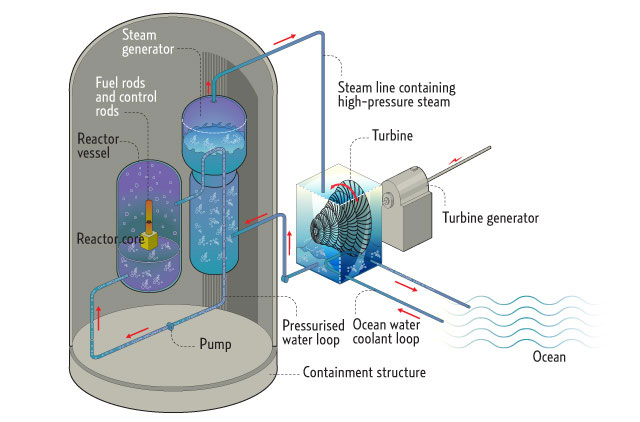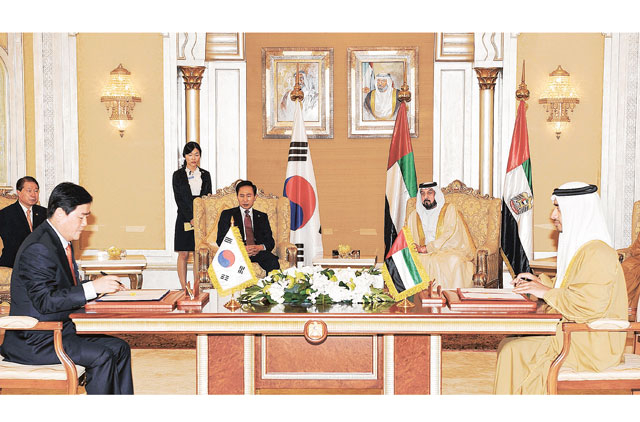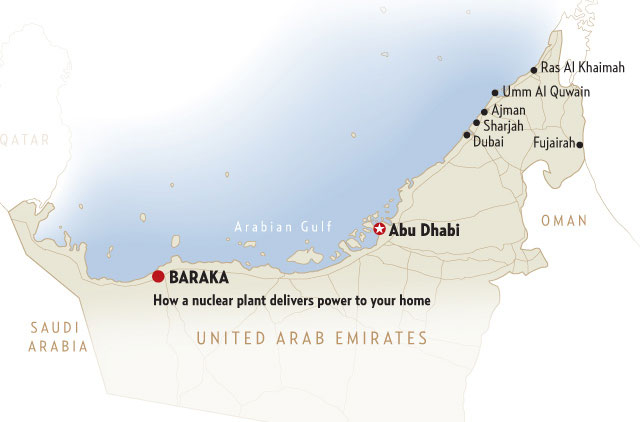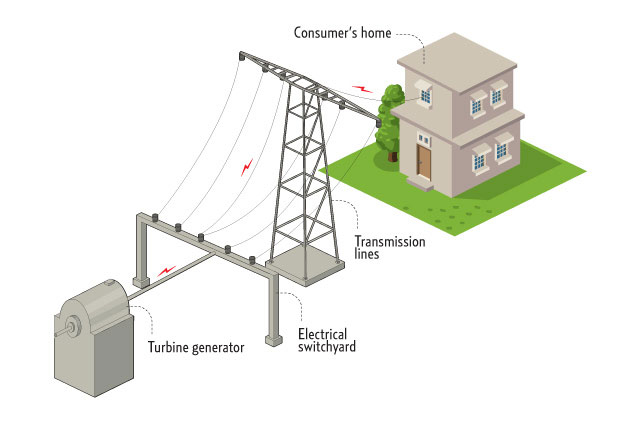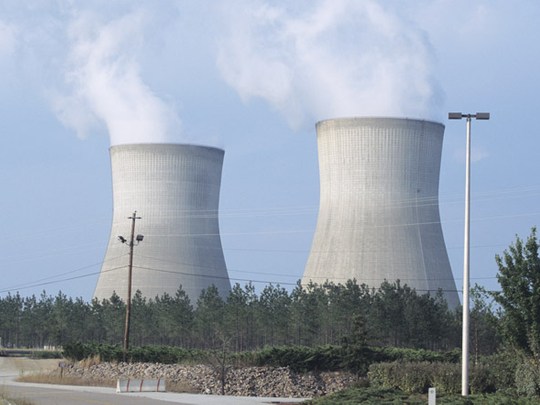
Work on the UAE's nuclear power stations has progressed well since the award of the contractin December 2009, and "the first unit is scheduled to come on stream on 1 May 2017, which is quite challenging," said Lee Hee-yong, Senior Vice President responsible for Korean Electric Power Corporation, Kepco's UAE Nuclear Project Division.
"At the Baraka site by the end of 2010 we will have finished the construction office, and we will issue the licensing documents which are required to get the construction licence. We will issue the preliminary safety analysis report, and the nuclear environment impact assessment. After they are reviewed and approved we will be able to get the construction permit, and start the work on the power block," Lee told Gulf News last month in an interview in Korea.
Right now there is only infrastructure work at the huge Baraka site, 270km from Abu Dhabi. At present there are over 700 people working at the site, including third country labour, but this will grow to a peak of about 10,000 people in 2015 or 2016, Lee said.
Eventually the nuclear reactor will not need such a large staff to run it.
"It is not fixed how many people will be needed when it is operating, but if it operates as we do in Korea, for two units we need about 300 or 350 people for operation and maintenance," said Lee.
The UAE is set to get 20 per cent of its power from nuclear energy by 2020, when the last of four units at the Baraka reactor in Abu Dhabi are due to be finished. This important shift in the country's energy strategy is proceeding according to plan, as the UAE embraces nuclear technology without all the fury that some other states in the region have attracted.
Nuclear power became the only viable option for the UAE as its population is expected to eventually double from its present 6.5 million, and the gas supplies will not be able to keep up when the demand for power goes up from under 16,000 megawatts at present to more than 40,000 MW by 2020.
Rival bidders
In December 2009, the Emirates Nuclear Energy Corporation, ENEC, selected Kepco to be the main contractor on the $20.4 billion (Dh74.9 billion) job, which seriously jolted the rival bidders from France and the United States. It was Kepco's first job outside Korea, but it won on technical and financial grounds. As ENEC announced at the time, particular care was taken to review Kepco's safety record, its ability to meet the UAE's programme goals, and importantly, its commitment to transferring knowledge into the UAE.
ENEC chairman Khaldoon Bin Mubarak commented that ENEC was looking for "a partnership that will endure for nearly 100 years" and ENEC CEO Mohammad Al Hamadi summed up the decision by saying that "we look forward to a long and productive relationship as we work toward powering the future growth of the UAE with low-carbon, peaceful nuclear energy".
Lee was clear that he completely agreed with the UAE's strategy, despite his initial surprise that one of the world's largest oil exporters needed to think about nuclear power.
"At first I was surprised to hear that the UAE wanted nuclear power, but the more I understood it, the more I realised that the Ruler's vision is right. The country needs sustainable energy for the long term," he said.
The technology the UAE is buying has been well tested. Reactors working in Korea will be reference sites for the Baraka units, allowing ENEC to test its technology against similar units and for UAE staff to go to the korean sites to train with exactly the same kind of technology.
The four units Kepco is building in the UAE will be the APR 1400, a Generation Three, 1,400 megawatt plant which is a Korean design based on an earlier Korean OPR 1000. There are four OPR 1000 reactors under final trial at present and due to come on stream from this year till 2012 at the Korean sites Shin Kori 1 and 2 and Shin Wolsong 1 and 2.
In addition, Korea is building its own APR 1400 units at Shin Kori 3 and 4. These will be ready in 2013 and 2014, and then two more APR 1400 will follow at Shin Ulchin 1 and 2 in 2016 and 2017. This means that the UAE's Baraka site will be the fifth of the APR series, and eight units will be operating by the time the Baraka site becomes fully operational, and the Shin Kori APR 1400 plants will be reference plants for the UAE.
Kepco has been building nuclear reactors since 1978, and in addition to the eight being built at present, there are also 20 reactors up and running in Korea. The latest are being built with 95 per cent indigenous Korean technology, which is set to US standards following the United States Nuclear Regulatory Commission (USNRC).
The first reactors in Korea were built by foreign contractors, but in 1998 they commissioned the first Korean Standard Nuclear Plant (KSNP), which was locally designed although based on technology from Combustion Engineering (now Westinghouse Electric Company). Kepco's partners in the UAE project include Westinghouse, as well as Samsung, Hyundai, and Toshiba.
The UAE's APR 1400 reactors are Generation Three, which have a plant life of 60 years, a substantial increase on the earlier Generation Two reactors which are expected to run for 40 years.
The UAE has been very clear that it does not want to enrich its own fuel, and it wants to work with international agencies to supply and take away the fuel. The UAE government sees this new style of transparent operation as a major guarantee to the world that it is not interested in anything other than the power which will be generated by the nuclear power stations.
"We will supply the core design and the first two reloads. They will then store the fuel in the spent fuel pits, which will have a capacity for 10 years," Lee told Gulf News, commenting that this was very safe as "we keep it longer in Korea".
Knowledge transfer is an important part of the project for Kepco and the UAE authorities.
Long-term partner
"During the construction phase we will develop a training centre, and start on-the-job training," said Lee.
"As the long-term partner in the project, we are also developing a training centre in Korea, and ENEC will also have its training centre in the UAE".
One obvious benefit of having reference sites operating in Korea is that the staff on the UAE project can go to Korea and train on the reactors which are already working.
"Trainees will come to Korea to work on the Shin Kori 3 and 4 reactors," said Lee.
The first step in knowledge transfer was to take 50 students from the Institute of Advanced Technology in Abu Dhabi, who visited Korea in July 2010 to receive specific training in the Sudo Electrical High School, and they also visited nuclear power plants and heavy machine factories such as those run by Doosan.
"In 2012 the Kepco International Nuclear Graduate School, KINGS, will take 100 students, of whom 50 will be foreigners, and we expect half of that 50 to be from the UAE," Lee said.
The success of Kepco's bid surprised more established nuclear exporters also in the race, such as a French consortium which included Areva, Suez, and Total; and a Japanese bid which included General Electric and Hitachi.
ENEC made its decision based on five core criteria, the company explained in its statement. Safety was the most important, then deliverability, contract compliance (which required a single prime contractor), human resource development, and lastly, commercial competitiveness.
The UAE site is Kepco's first export site, and while the company was confident that it had the right technology and pricing, it was a major step to get ready for such a project.
"We had to change all the systems from our domestic orientation into a more international oriented.
Prime contractor
"For example in Korea, Kepco is the owner and is responsible for the eventual management of the power station. But in Baraka, the owner is ENEC, and Kepco is the prime contractor, and the others are our subcontractors, so the relationships and responsibilities are totally different".
In addition to the project in the UAE, Kepco is looking at supplying reactors to other countries. The company has been in discussions in Turkey, and there are other countries such as Malaysia and South Africa where discussions are not yet quite active, Lee said.
The market for building nuclear reactors is getting very large. As Lee explained: "There are over 450 reactors in the world today, and many of these are due to retire in the foreseeable future.
"But in addition, the requirements for more power around the world mean that this number is likely to double to nearer 800 reactors worldwide very soon."
Lee admitted to interest from several Gulf countries, although he did not want to say which ones. "We have visitors from other Gulf states, and there are many from the Middle East who are interested in seeing the Sing Kori 3 and 4 reactors.
"There will be strong competition to introduce power plants in the Middle East. It is one of the big markets," he said.
Lee closed with a comment on the UAE's plans for power: "The UAE is aiming for 20 per cent of its power from nuclear sources, but in the long term I think that is not enough. I think the UAE will need more. In Korea our nuclear portion is over 50 per cent of capacity."


